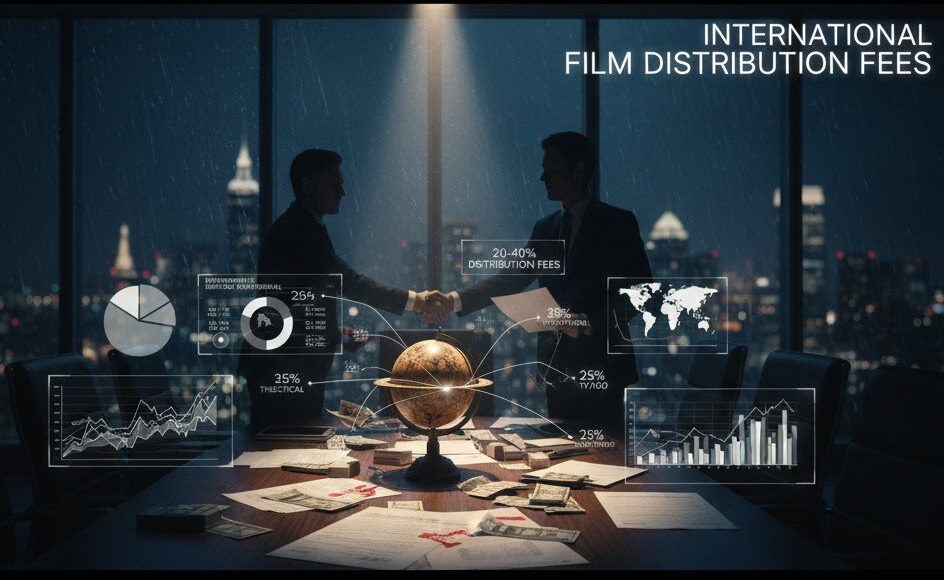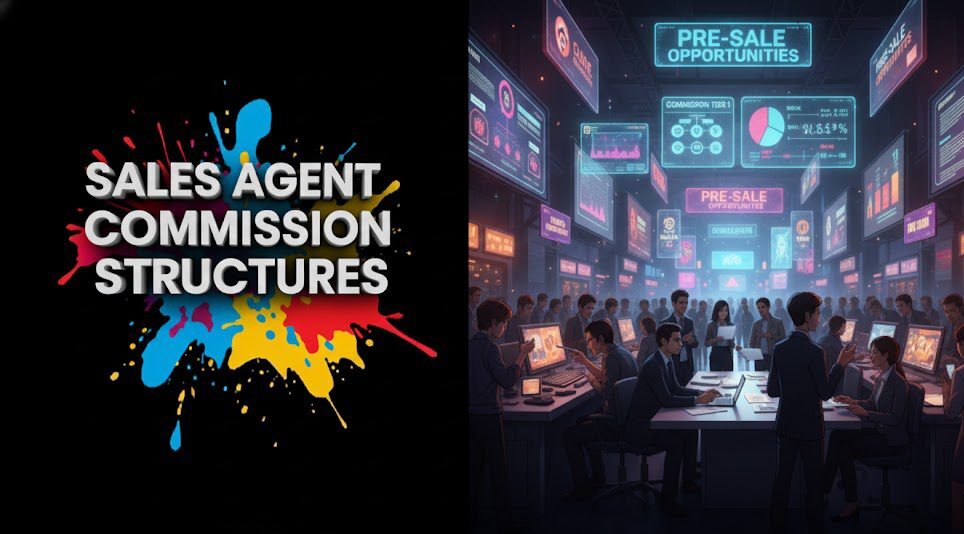Introduction
The film industry is in a perpetual state of evolution, and the horizon for film sales and distribution promises even more transformative changes. For all film industry professionals and strategists, anticipating the future of film distribution and understanding emerging film sales trends is not just insightful, it’s essential for staying relevant and successful.
This article will explore the exciting, and sometimes uncertain, road ahead, touching on concepts like virtual film markets, the potential of NFTs in film distribution, the continued growth of direct-to-consumer film models, the drive towards truly personalized film distribution, and the ever-increasing impact of AI on film consumption. Join us as we look at the innovations and shifts poise to redefine how films connect with global audiences.
Table of content
- Introduction
- Key-Takeaways
- The Ever-Dynamic Landscape: Forces Shaping the Future
- Emerging Distribution Models: DTC, Hybrid, and Beyond
- New Platforms and Technologies on the Horizon (Web3, NFTs)
- Evolving Viewer Preferences and Their Impact
- The Deepening Role of AI in Personalized Film Distribution
- Navigating the Future with Insights from Vitrina
- Conclusion
- FAQs
Key Takeaways
| Future Trend | Potential Impact |
|---|---|
| Hyper-Personalization | AI-driven content curation and marketing tailored to individual viewer tastes will become more sophisticated, influencing discovery and consumption. |
| Direct-to-Consumer (DTC) Growth | More creators and niche players will explore bypassing traditional intermediaries to build direct relationships with audiences. |
| Evolving Windowing Strategies | Theatrical, VOD, and streaming windows will continue to flex and adapt, with more hybrid and dynamic models emerging. |
| New Technologies (Web3, NFTs) | Technologies like NFTs may offer new avenues for funding, fan engagement, and fractional ownership/collectibility, though adoption is still early. |
| Data & AI Centrality | The impact of AI on film consumption and data analytics will become even more central to decision-making in sales, marketing, and content development. Vitrina aims to be a key resource here. |
Is Your Film Strategy Ready for Tomorrow's Trends?

The Ever-Dynamic Landscape: Forces Shaping the Future

The future of film distribution isn’t being shaped by a single factor, but by a confluence of powerful forces. Technological innovation, shifting consumer behaviors, new economic models, and global connectivity are all playing a part in redrawing the map. Understanding these macro trends is crucial for anticipating upcoming film sales trends and for adapting business strategies accordingly. The only certainty is that the pace of change will likely continue, demanding agility and foresight from all industry players.
Key technological drivers of change.
Technology continues to be a primary catalyst:
- Advancements in AI and Machine Learning: Impacting content discovery, recommendation engines, marketing automation, and even content creation/analysis. The impact of AI on film consumption patterns will be profound.
- Ubiquitous High-Speed Internet & Mobile Connectivity: Enabling seamless streaming and access to content anywhere, anytime, on any device.
- Cloud Computing: Revolutionizing production workflows, content storage, and global delivery.
- Interactive and Immersive Technologies (VR/AR/XR): While still niche, these offer potential for new narrative forms and viewing experiences that will require unique distribution models.
- Blockchain and Web3 Concepts: Exploring decentralized approaches to rights management, funding (e.g., via NFTs in film distribution), and fan engagement.
Shifting consumer behaviors and expectations.
Viewers are increasingly in the driver’s seat:
- Demand for Choice and Control: Audiences want to watch what they want, when they want, and where they want.
- Personalization: Expectation for content recommendations tailored to individual tastes.
- Subscription Fatigue vs. Ad Tolerance: A potential balancing act between willingness to pay for multiple SVOD services versus openness to ad-supported free content (AVOD).
- Desire for Authentic and Diverse Stories: Growing appetite for content that reflects a wider range of voices and experiences.
- Social and Interactive Viewing: Interest in shared experiences, watch parties, and engaging with content and creators on social media.
These evolving preferences directly influence which film distribution channels will thrive.
Economic and global market influences.
- Globalization of Content: Increased cross-border flow of films and TV shows, with international markets becoming ever more important for revenue.
- Consolidation vs. Niche Players: Major media conglomerates continue to consolidate, while new niche streaming services and independent distributors also emerge.
- Evolving Monetization Models: Constant experimentation with subscription tiers, hybrid models (SVOD with ads), dynamic pricing, and new revenue streams.
- The Creator Economy: More tools and platforms enabling individual creators to build and monetize their own audiences, potentially leading to more direct-to-consumer film releases.
| Driving Force | Specific Manifestation | Impact on Future Distribution |
|---|---|---|
| Technological Advancement | AI, 5G, Cloud, Web3 | More personalized delivery, new platforms, potentially decentralized models. |
| Consumer Behavior Shifts | On-demand expectation, desire for personalization. | Flexible windowing, growth of DTC, tailored content offerings. |
| Economic & Market Dynamics | Globalization, media consolidation, creator economy. | Increased focus on international sales, diverse business models. |
These forces are collectively shaping the future of film distribution.
Emerging Distribution Models: DTC, Hybrid, and Beyond
As the landscape shifts, so too do the models for film sales and distribution. While traditional theatrical and home entertainment pathways will continue to exist, we’re seeing a significant rise in innovative and flexible approaches. The growth of direct-to-consumer (DTC) film strategies, the increasing prevalence of hybrid release models, and the exploration of community-driven distribution are all indicative of a move towards greater adaptability and, in some cases, a desire for more direct control by creators and rights holders. These emerging models are key film sales trends to watch.
The continued rise of Direct-to-Consumer (DTC) models.
Direct-to-consumer film distribution involves creators or content owners bypassing traditional intermediaries (like third-party distributors or broadcasters) to offer their films directly to audiences, usually via their own branded websites or streaming apps.
Advantages:
- Higher Revenue Share Per Transaction: Creators keep a larger portion of the sales/rental income.
- Direct Audience Relationship: Ability to gather first-party data, build community, and communicate directly with fans.
- Full Control over Branding and Pricing.
Challenges:
- Significant Marketing Effort and Cost: Driving traffic and acquiring customers without a major platform’s reach is difficult.
- Technical Infrastructure: Requires setting up and maintaining a robust streaming/e-commerce platform.
- Content Volume: Often harder to attract and retain users with a limited library compared to large aggregators.
DTC is becoming more viable for established brands, filmmakers with strong existing fanbases, or highly niche content.
Hybrid release strategies: Blending theatrical, VOD, and streaming.
Increasingly, we’re seeing less rigid adherence to traditional windowing. Hybrid models are becoming common:
- Day-and-Date Releases: Releasing a film in theaters and on a VOD/streaming platform simultaneously.
- Shortened Theatrical Windows: Moving films to home entertainment much faster (e.g., 17-45 days after theatrical debut).
- Dynamic Windowing: Adjusting release windows based on a film’s performance in earlier channels.
- Festival Premiere to Targeted VOD: Using a festival launch for buzz, followed by a curated VOD release on specific platforms.
These strategies aim to maximize revenue across multiple channels and cater to different audience segments’ viewing preferences. The future of film distribution will likely see even more experimentation here.
Community-driven and event-based distribution.
Beyond broad releases, there’s growing interest in:
- Theatrical-on-Demand/Crowdsourced Screenings: Platforms that allow audiences to request screenings of films in their local theaters, guaranteeing an audience before a booking is made.
- Pop-Up Cinemas and Special Event Screenings: Creating unique, immersive viewing experiences.
- Fan-Powered Distribution: Leveraging dedicated fan communities to promote and organize screenings or online watch parties.
These models foster a stronger sense of community and can be particularly effective for independent films with passionate followings.
| Emerging Model | Key Characteristic | Potential Benefit for Filmmakers |
|---|---|---|
| Direct-to-Consumer (DTC) | Selling/streaming directly to audiences. | Higher revenue share, direct fan data & relationship. |
| Hybrid Release Models | Flexible, multi-channel release timing. | Optimized revenue across platforms, caters to varied viewer habits. |
| Community-Driven Distribution | Leveraging fan engagement for promotion/screenings. | Cost-effective marketing, guaranteed audiences for events. |
| Dynamic Windowing | Release windows adjust based on performance. | Maximizes earning potential of each channel. |
Adaptability and innovation will define the most successful distribution models moving forward.
New Platforms and Technologies on the Horizon (Web3, NFTs)
The quest for innovation in the future of film distribution extends to exploring entirely new technological frontiers. Concepts emerging from Web3, such as Non-Fungible Tokens (NFTs), are beginning to intersect with the film world, offering potential new ways to fund projects, engage fans, and even manage rights. While still in early and experimental stages, these technologies represent intriguing film sales trends and potential disruptions to traditional models. The rise of more interactive and perhaps even virtual film markets built on these technologies is also a possibility.
Exploring Web3 and its potential for decentralized film distribution.
Web3 generally refers to a vision of a more decentralized internet built on blockchain technologies. For film, this could theoretically lead to:
- Decentralized Funding Platforms: Allowing creators to raise funds directly from a global community without traditional intermediaries, perhaps using cryptocurrencies or security tokens.
- Transparent Rights Management: Using blockchain to create immutable records of film rights ownership and licensing, potentially simplifying royalty distribution.
- Community Ownership/Governance: Models where fans or token holders have a say in creative decisions or share in a film’s success.
Significant technical, legal, and adoption hurdles remain, but the underlying concepts are being actively explored.
NFTs in film distribution: Funding, collectibles, and fan engagement.
NFTs in film distribution (and production) are currently being experimented with in several ways:
- Funding: Selling NFTs that represent a share of future profits, access to exclusive content, or involvement in the filmmaking process to raise production or distribution funds.
- Collectibles: Creating limited-edition digital collectibles related to a film (e.g., digital posters, character art, iconic scenes) for fans.
- Exclusive Access & Experiences: NFTs granting holders access to private screenings, Q&As with cast/crew, or other unique perks.
- Proof of Ownership/Authenticity: For rare digital art or film-related assets.
The long-term viability and mainstream adoption of NFTs in film are still uncertain, but they offer intriguing possibilities for fan engagement and alternative financing/monetization.
The evolution of virtual film markets and online pitching platforms.
While physical markets remain vital, virtual film markets and online pitching platforms saw a surge during the pandemic and are likely to remain part of the landscape:
- Increased Accessibility: Allowing more filmmakers and buyers from around the world to participate without the high cost of travel.
- Efficiency: Online tools for scheduling meetings, screening films, and sharing materials.
- Hybrid Models: Physical markets incorporating stronger digital components for those who cannot attend in person.
These platforms will continue to evolve, potentially integrating more sophisticated tools for discovery, networking, and even deal-making, further shaping how film sales trends develop.
| New Technology/Platform | Potential Application in Film | Current Status/Challenge |
|---|---|---|
| Web3/Decentralized Models | Direct funding, transparent rights management, community governance. | Highly experimental, scalability and regulatory uncertainty. |
| NFTs | Alternative funding, digital collectibles, exclusive fan access. | Volatile market, mainstream understanding/adoption still developing. |
| Virtual Film Markets | Accessible global participation, efficient discovery. | Replicating the serendipity of in-person networking. |
| Interactive Content Platforms | New narrative forms, personalized viewing paths. | Production complexity, developing monetization models. |
These emerging technologies hint at exciting possibilities for the future of film distribution.
Navigate the Evolving Film Industry with Confidence!

Evolving Viewer Preferences and Their Impact
At the heart of all film sales trends and shifts in the future of film distribution are the viewers themselves. Audience preferences are not static; they evolve with cultural shifts, technological advancements, and changing lifestyle patterns. Understanding these evolving tastes – from content consumption habits to genre preferences and expectations around interactivity – is crucial for anyone hoping to create and distribute successful films in the years to come. The impact of AI on film consumption, particularly through personalized recommendations, is also a major factor in shaping these preferences.
The demand for personalized and curated content experiences.
Viewers are increasingly accustomed to highly personalized experiences online, and this extends to their content consumption:
- Algorithmic Recommendations: Sophisticated AI-driven suggestions on streaming platforms are shaping what people discover and watch.
- Niche Content Curation: Growing interest in platforms or curated lists that cater to very specific tastes or genres, moving beyond one-size-fits-all programming.
- Desire for Discovery Tools: While algorithms help, viewers also seek trusted human curators, critics, and influencers to guide them through the vast content landscape.
This trend will drive demand for even more sophisticated personalized film distribution strategies.
The impact of social media and interactive viewing on consumption habits.
Social media and interactivity are changing how audiences engage with films:
- Second Screen Experience: Viewers often engage on social media while watching, sharing reactions and discussing plot points in real-time.
- Influence of Social Buzz: Recommendations from friends, influencers, or trending topics on social media can significantly drive viewing choices.
- Demand for Interactive Narratives: While still niche, some audiences are intrigued by “choose your own adventure” style films or content with interactive elements.
- Community Viewing: Online watch parties and live-streamed Q&As with filmmakers create a sense of shared experience around a film’s release.
The growing appetite for global stories and diverse voices.
Audiences are becoming more receptive to content from around the world:
- Success of Non-English Language Content: Films and series from countries like South Korea, Spain, and Germany have found massive global audiences on streaming platforms.
- Demand for Authenticity and Representation: Viewers are seeking stories that reflect a wider range of cultures, experiences, and perspectives.
- Ease of Access: Improved subtitling and dubbing, along with global platform availability, are making international content more accessible than ever.
This trend creates enormous opportunities for filmmakers from all backgrounds and for distributors specializing in international content.
| Viewer Preference Shift | Implication for Distribution Strategy | Example |
|---|---|---|
| Demand for Personalization | Need for better content tagging, targeted marketing, AI-driven recommendations. | A streaming service suggesting films based on your detailed viewing history. |
| Influence of Social Media | Importance of online buzz, influencer marketing, community engagement. | A film trending on X (Twitter) drives significant VOD rentals. |
| Appetite for Global Content | Increased opportunity for international sales and cross-cultural hits. | A Korean drama becoming a global phenomenon on Netflix. |
| Interest in Interactivity | Potential for new narrative forms and engagement models. | A film with branching storylines controlled by the viewer. |
The future of film distribution will be keenly attuned to these evolving audience desires.
The Deepening Role of AI in Personalized Film Distribution
As we look towards the future of film distribution, Artificial Intelligence (AI) is set to play an increasingly central role, particularly in delivering highly personalized film distribution experiences. The sheer volume of content available makes manual curation for individual users impossible on a large scale. AI algorithms are becoming indispensable tools for analyzing viewer data, predicting preferences, and tailoring content discovery and marketing in ways previously unimaginable. This impact of AI on film consumption is one of the most significant ongoing film sales trends.
AI-powered recommendation engines and content discovery.
This is already a mature application of AI, but it will only get more sophisticated:
- Granular Analysis: AI can analyze not just genre and cast, but also a film’s pacing, themes, visual style, emotional tone, and even specific plot elements to match it with viewer profiles.
- Predictive Matching: Moving beyond what a user *has* watched to predict what they *will want* to watch, even if it’s outside their usual genres.
- Contextual Recommendations: Factoring in time of day, device, current mood (if inferable), or even trending topics to make suggestions more relevant.
The goal is a seamless discovery process that keeps viewers engaged and reduces churn on platforms.
Personalized marketing and audience targeting using AI.
AI enables hyper-targeted marketing campaigns:
- Micro-Segmentation of Audiences: Identifying very specific audience niches based on complex combinations of demographic, psychographic, and behavioral data.
- Dynamic Creative Optimization: AI can help create and test multiple versions of trailers, ads, or promotional copy to see which resonates best with different audience segments.
- Predictive Churn Prevention: Identifying subscribers at risk of leaving a platform and targeting them with specific content recommendations or offers.
- Optimized Ad Spend: Ensuring marketing budgets are focused on the individuals most likely to convert (watch the film, subscribe, etc.).
Ethical considerations in AI-driven personalization.
While powerful, AI-driven personalization also raises ethical questions for the future of film distribution:
- Filter Bubbles and Echo Chambers: Will over-personalization limit exposure to diverse viewpoints or challenging content if AI only shows us what it thinks we already like?
- Data Privacy: How is vast amounts of personal viewing data being collected, stored, and used? Transparency and user control are crucial.
- Algorithmic Bias: Ensuring AI models don’t inadvertently discriminate against certain types of films or filmmakers due to biases in their training data.
- Impact on Serendipitous Discovery: The joy of stumbling upon something unexpected might be reduced if everything is too perfectly curated.
Balancing the benefits of personalization with these ethical concerns will be a key challenge.
| AI Application in Personalization | Benefit | Ethical Consideration |
|---|---|---|
| Sophisticated Recommendation Engines | Improved content discovery, increased viewer engagement. | Potential for filter bubbles, lack of serendipity. |
| Hyper-Targeted Marketing | More efficient ad spend, higher conversion rates. | Data privacy, potential for manipulation. |
| Predictive Audience Behavior Analysis | Better content alignment with demand, reduced churn. | Risk of algorithmic bias influencing what gets made/seen. |
The impact of AI on film consumption will continue to be a defining feature of future film sales trends.
Navigating the Future with Insights from Vitrina
As the future of film distribution unfolds with its emerging models, new technologies, and evolving viewer preferences, staying informed and agile is more critical than ever. For film industry professionals looking to navigate these dynamic film sales trends, access to comprehensive and forward-looking market intelligence is invaluable. This is where a platform like Vitrina can serve as a vital partner, helping to make sense of the changes and identify opportunities in a rapidly transforming global landscape, including understanding the potential of virtual film markets and new avenues like NFTs in film distribution.
How Vitrina helps industry professionals anticipate and adapt to changes.
Vitrina’s commitment to tracking global content, deals, and platform strategies positions it to help users:
- Identify Early Trends: By monitoring what types of content are being commissioned, acquired, and consumed across different platforms and territories, Vitrina can help spot emerging patterns before they become mainstream. This includes tracking new direct-to-consumer film initiatives.
- Understand Platform Evolution: As new streaming services launch or existing ones pivot their strategies (e.g., introducing ad-supported tiers, exploring personalized film distribution), Vitrina provides insights into these shifts.
- Monitor New Technology Adoption: Tracking how innovations like AI or even early experiments with Web3/NFTs are beginning to impact content strategies and distribution deals.
- Assess Global Market Shifts: Understanding how viewer preferences and regulatory changes in key international territories might impact future demand for specific types of content.
This forward-looking intelligence enables users to adapt their own strategies proactively.
The importance of data in planning for next-generation distribution.
In a future increasingly shaped by data, intuition alone won’t be enough. Strategic planning will rely on:
- Understanding Audience Micro-Segments: Data helps identify and target increasingly niche audiences with tailored content and marketing.
- Optimizing Release Windows Dynamically: Real-time or near real-time data could inform more flexible and responsive windowing strategies.
- Valuing Content for New Platforms/Models: As new monetization opportunities arise (e.g., via NFTs or interactive content), data will be needed to assess their potential.
- Measuring the ROI of Emerging Technologies: Tracking the effectiveness of AI-driven marketing or new distribution channels.
Vitrina’s solution aims to provide the foundational data that supports this next-generation strategic planning, helping users make sense of the impact of AI on film consumption and other key shifts.
| Future Challenge/Opportunity | How Vitrina’s Insights Can Assist |
|---|---|
| Emergence of New Distribution Models (DTC, Hybrid) | Tracking examples, identifying key players and successful strategies. |
| Adoption of New Technologies (AI, Web3, NFTs) | Monitoring early use cases, impact on content deals and fan engagement. |
| Shift to Hyper-Personalization | Providing data on content attributes that drive engagement with specific segments. |
| Growth of Virtual/Online Market Interactions | Offering a consistent source of global buyer/seller intelligence accessible remotely. |
Staying informed through platforms like Vitrina will be key to thriving in the future of film distribution.
Conclusion
The future of film distribution and a Glimpse into emerging film sales trends reveals a landscape brimming with innovation, driven by technological leaps, evolving audience expectations, and new economic realities. From the rise of direct-to-consumer film models and the increasing sophistication of personalized film distribution powered by AI, to the experimental frontiers of Web3 and NFTs in film distribution, change is the only constant. For film industry professionals, success in this next chapter will hinge on adaptability, a willingness to embrace data, a keen understanding of global viewer preferences, and the strategic use of platforms like Vitrina that provide clarity in a complex world. The journey ahead is exciting, and those who anticipate and navigate these shifts will be best positioned to connect stories with audiences in impactful new ways.
Stay ahead of the curve in the evolving world of film. Explore Vitrina to gain the intelligence and insights needed to navigate the future of film distribution and capitalize on emerging trends.
Frequently Asked Questions
It’s highly unlikely that theatrical releases will disappear entirely, especially for big event films and certain types of art-house cinema. However, the theatrical window will likely continue to evolve, becoming more flexible and coexisting with various VOD and streaming strategies. The communal experience of cinema still holds value for many.
AI is more likely to augment rather than replace the roles of distributors and sales agents. It can provide them with better tools for market analysis, audience targeting, and identifying potential buyers or content. However, human expertise in negotiation, relationship-building, and creative strategy will remain crucial in navigating film sales trends.
The long-term viability of NFTs in film distribution is still being determined. While they offer interesting possibilities for crowdfunding, fan engagement, and digital collectibles, the market is volatile, and mainstream adoption and understanding are still developing. It’s an area to watch with cautious optimism and experimentation.
Smaller filmmakers should focus on building a direct connection with their audience (e.g., via social media, email lists), staying adaptable, exploring niche distribution opportunities, understanding the basics of data, and continuously learning about new technologies and platforms. Being agile and entrepreneurial will be key.
Explore the full journey from strategy to global reach in our ultimate guide: The Essential Guide to Film Sales and Distribution in the Modern Era: From Strategy to Global Reach.






































